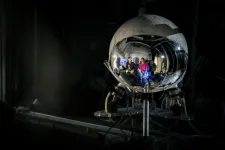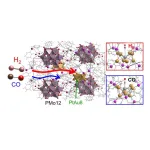(Press-News.org) A new mathematical model sheds light on how the brain processes different cues, such as sights and sounds, during decision making. The findings from Princeton neuroscientists may one day improve how brain circuits go awry in neurological disorders, such as Alzheimer’s, and could help artificial brains, like Alexa or self-driving car technology, more helpful.
The findings were published February 10 in the journal Nature Neuroscience.
Walking to work, commuters encounter many sensory signals along their route, such as the glow of a crosswalk signal that indicates whether it’s safe to cross or beware of oncoming traffic. As the crude cartoon of a person walking lights up and people start to cross, a roaring ambulance might bolt down the block and towards the intersection.
Precisely how the brain juggles conflicting and related sensory information, such as colored signals and loud sirens, and makes a sensible decision has been long studied but still a mystery.
One brain region critical for decision making is the prefrontal cortex, which sits just behind the eyes and is lauded as the epicenter of higher cognition.
Previous research found that the response of single brain cells in the prefrontal cortex during decision-making is multifaceted and complex. For example, a neuron in the prefrontal cortex may only fire in response to a green traffic light when there is a car blocking the crosswalk. A unified understanding of how brain cells in the prefrontal cortex process sensory information, like traffic signals, and then generate behavioral outputs, like deciding to jaywalk, however, has eluded researchers.
Different mathematical approaches have been used before to try to understand the circuit mechanisms linking neural dynamics to behavioral output, each with their own limitations. One approach center on recurrent neural networks, a type of neural circuit model that consists of many recurrently connected units. Recurrent neural networks can be trained to perform decision-making tasks, but the density of their recurrent connections makes them hard to interpret.
In their recent paper, postdoctoral researcher Christopher Langdon, Ph.D., and assistant professor of neuroscience Tatiana Engel, Ph.D., propose a new mathematical framework to better explain decision making dubbed the latent circuit model.
Instead of a complex recurrent neural network model, Langdon and Engel propose a sort of trees instead of the forest approach. To make sense of a large network of brain activity and trying to understand how each cell’s behavior is influenced by another, maybe just a few nerve cell ringleaders can explain the whole crowd’s activity and influence decision making, what neuroscientists call a “low-dimensional” mechanism.
“The goal of the research was to understand if low-dimensional mechanisms were operating inside large recurrent neural networks” Langdon said.
To test their hypothesis, Langdon and Engel first applied their new model to recurrent neural networks trained to perform a context-dependent decision-making task.
The task, performed by humans, monkeys, or computers, begins with a shape on a screen (square vs. triangle, context cue), followed by a moving grid (sensory cue). Based on the shape, the participant is asked to report either the color (red vs. green) or the motion (left vs. right) of the moving grid.
Using their new model, Langdon and Engel found that when motion was the important cue for participants to track, prefrontal cortex cells that process shape shut off neighboring cells that pay attention to color. The opposite was true when asked to discriminate red versus green.
“It was very exciting to find an interpretable, concreate mechanism hiding inside a big network,” Langdon said.
The latent circuit model makes predictions about how choices should change when the strength of connections between different latent nodes is altered. This is powerful because it allows researchers to validate if latent connectivity structure is actually needed to support task performance. Indeed, the authors found that task performance suffered in predictable ways when removing specific connections in the circuit.
“The cool thing about our new work is that we showed how you can translate all those things that you can do with a circuit onto a big network,” Langdon said. “When you build a small neural circuit by hand, there’s lots of things you can do to convince yourself you understand it. You can play with connections and perturb nodes, and have some idea what should happen to behavior when you play with the circuit in this way.”
The human brain, with more neurons than there are stars in the Milky Way, is dauntingly complex. This new latent circuit model, though, opens new possibilities for revealing mechanisms that explain how connectivity amongst hundreds of brain cells gives rise to the computations that drive people to make different choices.
Challenges with decision-making are a hallmark of several complex mental health disorders, ranging from depression to attention deficit hyperactive disorder. By revealing the mathematical computations performed by the brain to help people make decisions, these findings may lend itself to better understanding these challenging conditions, and for enhancing the decision-making capacity of technologies from digital assistants like Alexa to self-driving cars. The first steps, however, involve applying this new model to other decision-making tasks that are commonly used in the laboratory.
“A lot of the tightly controlled decision-making tasks that experimentalist study, I believe that they likely have relatively simple latent mechanisms” Langdon said. “My hope is that we can start looking for these mechanisms now in those datasets.”
END
Princeton neuroscientists crack the code of how we make decisions
A new mathematical framework uncovers how the brain’s prefrontal cortex processes mixed signals to guide decision making, offering fresh insights for both clinical care and next-generation AI
2025-02-10
ELSE PRESS RELEASES FROM THIS DATE:
Trump's 2024 election victory: A double-edged sword for the US stock market
2025-02-10
Financial markets are reacting not just to Donald Trump's return to the White House but also to the unpredictability of this victory, according to a new study from the University of Surrey. Investors must diversify their portfolios to mitigate risks associated with political volatility and to remain vigilant about the potential for abrupt market corrections.
A new study, published in Economics Letters, indicates that while there was an immediate surge in stock prices following Trump's election, this was quickly tempered by investor concerns over potential trade wars and international instability.
A group of ...
High-tech video optimization in our brain
2025-02-10
Why do our mental images stay sharp even when we are moving fast? A team of neuroscientists led by Professor Maximilian Jösch at the Institute of Science and Technology Austria (ISTA) has identified a mechanism that corrects visual distortions caused by movement in animals. The study, conducted in mice, identifies a core function that can be generalized across the vertebrate visual system, including primates such as humans. The findings are published in Nature Neuroscience.
Despite its rapid development in recent decades, the video camera industry is still catching up with the capabilities of the human eye. In particular, action cams are designed ...
Euclid discovers a stunning Einstein ring
2025-02-10
Euclid blasted off on its six-year mission to explore the dark Universe on 1 July 2023. Before the spacecraft could begin its survey, the team of scientists and engineers on Earth had to make sure everything was working properly. During this early testing phase, in September 2023, Euclid sent some images back to Earth. They were deliberately out of focus, but in one fuzzy image Euclid Archive Scientist Bruno Altieri saw a hint of a very special phenomenon and decided to take a closer look.
“I look at the data from Euclid as it comes in,” explains Bruno. “Even from that first observation, I could see it, but after Euclid made more observations of the area, ...
Biotech in Germany has significant potential, but lack of collaboration hampers growth
2025-02-10
The report “Assessing Deep-Tech Innovation Hubs in Germany: The Case of Biotechnology” evaluates Germany’s performance in deep-tech innovation within biotech using a comprehensive index and examines five key hubs: Berlin, Heidelberg, Munich, Nuremberg-Erlangen, and Stuttgart. These hubs were analyzed in terms of fundamental research, research and development in biotech, startup activity, public infrastructure, and business environment.
Berlin, Munich, and Heidelberg are the leading biotech hubs
Berlin leads the index due to its strong public infrastructure ...
Does pain affect cancer survivors’ use of non-opioid substances?
2025-02-10
Experiencing pain may increase the odds that cancer survivors will use cigarettes and cannabis, according to a recent study published by Wiley online in CANCER, a peer-reviewed journal of the American Cancer Society. The study also found that cigarette smoking and pain are linked to more treatment-related side effects and worse health among cancer survivors.
Pain and use of cigarettes, e-cigarettes, alcohol, and cannabis commonly occur together in the general population. To characterize pain in relation to such non-opioid substance ...
Scientists find that a playful approach to life activates ‘lemonading’, which helps people cope with adversity
2025-02-10
Scientists have found that taking a playful approach to life doesn’t mean you don’t take your situation seriously, but it can mean you cope with it better. By surveying people about their experiences during a Covid-19 lockdown, they learned that more playful people were more positive about the future and coped more actively and creatively. Life gave them lemons, and they made lemonade.
“Our study revealed that playfulness and resilience are intimately connected through what we call ‘lemonading’ — the ability to imagine ...
Candidate genes in canine hepatocellular carcinoma for molecular targeted therapy
2025-02-10
Unresectable canine hepatocellular carcinoma (HCC) has limited nonsurgical treatment options. Sorafenib is a targeted therapy for unresectable canine HCC. However, there are limited reports on the expression of target genes. Therefore, the efficacy of the targeted therapies for canine HCC remains unclear.
In HCC, the prognosis is generally good when complete surgical resection is possible. Unresectable nodular and diffuse HCC have a poor prognosis and limited nonsurgical treatment options. In humans, systemic therapies including ...
Opioid prescriptions in the ED linked to small increases in future opioid use, hospitalizations
2025-02-10
Opioid prescriptions in the emergency department (ED) were associated with small increases in later opioid prescriptions and hospital admissions, found new research published in CMAJ (Canadian Medical Association Journal) https://www.cmaj.ca/lookup/doi/10.1503/cmaj.241542.
To understand the relationship between opioid prescribing in the ED and subsequent harm, researchers looked at opioid prescribing at all Alberta EDs from 2010 to 2020. Of the more than 13 million visits, 689 074 patients (5.3%) filled an opioid prescription. The researchers found that opioid prescriptions did not increase the risk of ...
During pandemic, playful people were remarkably resilient, OSU research shows
2025-02-10
CORVALLIS, Ore. – Adults with high levels of playfulness showed strong resilience during the COVID-19 pandemic compared to less playful individuals, new research shows.
The study led by Xiangyou “Sharon” Shen of Oregon State University is important because playfulness is a vital but underappreciated resource for building resilience and maintaining well-being during difficult periods such as the pandemic, Shen said. And it’s a resource that individuals can cultivate.
“Understanding how playful people navigate adversity can inform interventions and strategies to help people cope with stress and uncertainty,” said Shen, an assistant professor ...
Tracing gas adsorption on “crowns” of platinum and gold connected by nanotunnels
2025-02-08
Tokyo, Japan – Researchers from Tokyo Metropolitan University have elucidated how hydrogen and carbon monoxide is adsorbed into solids containing a crown-motif structure of platinum and gold. Using quick-scan X-ray absorption measurements and theoretical calculations, they studied a solid of [PtAu8(PPh3)8]-H[PMo12O40] called PtAu8-PMo12 and found that gas adsorption is affected strongly by the dimension of nanoscale voids in the structure. This highlights the importance of engineering voids in materials for next generation sensors and gas separation.
Ligand-protected metal clusters have been a source of ...
LAST 30 PRESS RELEASES:
Heart-brain connection: international study reveals the role of the vagus nerve in keeping the heart young
Researchers identify Rb1 as a predictive biomarker for a new therapeutic strategy in some breast cancers
Survey reveals ethical gaps slowing AI adoption in pediatric surgery
Stimulant ADHD medications work differently than thought
AI overestimates how smart people are, according to HSE economists
HSE researchers create genome-wide map of quadruplexes
Scientists boost cell "powerhouses" to burn more calories
Automatic label checking: The missing step in making reliable medical AI
Low daily alcohol intake linked to 50% heightened mouth cancer risk in India
American Meteorological Society announces Rick Spinrad as 2026 President-Elect
Biomass-based carbon capture spotlighted in newly released global climate webinar recording
Illuminating invisible nano pollutants: advanced bioimaging tracks the full journey of emerging nanoscale contaminants in living systems
How does age affect recovery from spinal cord injury?
Novel AI tool offers prognosis for patients with head and neck cancer
Fathers’ microplastic exposure tied to their children’s metabolic problems
Research validates laboratory model for studying high-grade serous ovarian cancer
SIR 2026 delivers transformative breakthroughs in minimally invasive medicine to improve patient care
Stem Cell Reports most downloaded papers of 2025 highlight the breadth and impact of stem cell research
Oxford-led study estimates NHS spends around 3% of its primary and secondary care budget on the health impacts of heat and cold in England
A researcher’s long quest leads to a smart composite breakthrough
Urban wild bees act as “microbial sensors” of city health.
New study finds where you live affects recovery after a hip fracture
Forecasting the impact of fully automated vehicle adoption on US road traffic injuries
Alcohol-related hospitalizations from 2016 to 2022
Semaglutide and hospitalizations in patients with obesity and established cardiovascular disease
Researchers ‘listen in’ to embryo-mother interactions during implantation using a culture system replicating the womb lining
How changing your diet could help save the world
How to make AI truly scalable and reliable for real-time traffic assignment?
Beyond fragmented markets: A new framework for efficient and stable ride-pooling
Can shape priors make road perception more reliable for autonomous driving?
[Press-News.org] Princeton neuroscientists crack the code of how we make decisionsA new mathematical framework uncovers how the brain’s prefrontal cortex processes mixed signals to guide decision making, offering fresh insights for both clinical care and next-generation AI



